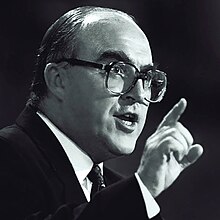
Back جون سميث (سياسي) Arabic جون سميث (محامى) ARZ John Smith (arweinydd y Blaid Lafur) Welsh John Smith (Politiker, 1938) German John Smith (político británico) Spanish جان اسمیت (رهبر حزب کارگر) Persian John Smith (poliitikko) Finnish John Smith (homme politique) French John Smith (ceannaire ar Pháirtí an Lucht Oibre, R.A.) Irish John Smith Scots/Gaelic
John Smith | |||||||||||||||
|---|---|---|---|---|---|---|---|---|---|---|---|---|---|---|---|
 Smith, c. 1992–1994 | |||||||||||||||
| Leader of the Opposition | |||||||||||||||
| In office 18 July 1992 – 12 May 1994 | |||||||||||||||
| Monarch | Elizabeth II | ||||||||||||||
| Prime Minister | John Major | ||||||||||||||
| Preceded by | Neil Kinnock | ||||||||||||||
| Succeeded by | Margaret Beckett | ||||||||||||||
| Leader of the Labour Party | |||||||||||||||
| In office 18 July 1992 – 12 May 1994 | |||||||||||||||
| Deputy | Margaret Beckett | ||||||||||||||
| Preceded by | Neil Kinnock | ||||||||||||||
| Succeeded by | Tony Blair | ||||||||||||||
| |||||||||||||||
| Secretary of State for Trade | |||||||||||||||
| In office 11 November 1978 – 4 May 1979 | |||||||||||||||
| Prime Minister | James Callaghan | ||||||||||||||
| Preceded by | Edmund Dell | ||||||||||||||
| Succeeded by | John Nott | ||||||||||||||
| Minister of State for the Privy Council | |||||||||||||||
| In office 8 April 1976 – 11 November 1978 | |||||||||||||||
| Prime Minister | James Callaghan | ||||||||||||||
| Preceded by | The Lord Crowther-Hunt | ||||||||||||||
| Succeeded by | The Baroness Birk | ||||||||||||||
| Minister of State for Energy | |||||||||||||||
| In office 4 December 1975 – 8 April 1976 | |||||||||||||||
| Prime Minister | Harold Wilson | ||||||||||||||
| Preceded by | The Lord Balogh | ||||||||||||||
| Succeeded by | Dickson Mabon | ||||||||||||||
| Parliamentary Under-Secretary of State for Energy | |||||||||||||||
| In office 18 October 1974 – 4 December 1975 | |||||||||||||||
| Prime Minister | Harold Wilson | ||||||||||||||
| Preceded by | Gavin Strang | ||||||||||||||
| Succeeded by | The Lord Lovell-Davis | ||||||||||||||
| Member of Parliament for Monklands East North Lanarkshire (1970–1983) | |||||||||||||||
| In office 18 June 1970 – 12 May 1994 | |||||||||||||||
| Preceded by | Margaret Herbison | ||||||||||||||
| Succeeded by | Helen Liddell | ||||||||||||||
| Personal details | |||||||||||||||
| Born | 13 September 1938 Dalmally, Argyll, Scotland | ||||||||||||||
| Died | 12 May 1994 (aged 55) London, England | ||||||||||||||
| Resting place | Reilig Odhráin, Iona, Scotland | ||||||||||||||
| Political party | Labour | ||||||||||||||
| Spouse | |||||||||||||||
| Children | 3, including Sarah and Catherine | ||||||||||||||
| Education | Dunoon Grammar School | ||||||||||||||
| Alma mater | University of Glasgow | ||||||||||||||
| Signature |  | ||||||||||||||
John Smith QC (13 September 1938 – 12 May 1994) was a Scottish politician who was Leader of the Opposition and Leader of the Labour Party from July 1992 until his death in May 1994. He was also Member of Parliament (MP) for Monklands East.
Smith first entered Parliament in 1970 and, following junior ministerial roles as Minister of State for Energy (1975–1976) and Minister of State for the Privy Council Office (1976–1978), he entered the Cabinet towards the end of James Callaghan's tenure as Prime Minister, as Secretary of State for Trade and President of the Board of Trade (1978–1979). During Labour's time in Opposition to Margaret Thatcher's Conservative government, he rose through the Shadow Cabinet, as Shadow Secretary of State for Trade (1979–1982), Energy (1982–1983), Employment (1983–1984), Trade and Industry (1984–1987) and Shadow Chancellor of the Exchequer (1987–1992).
After Labour leader Neil Kinnock resigned following the Party's surprise loss in the 1992 general election to new Conservative leader John Major, Smith was elected his successor in July 1992. He continued Kinnock's moves to reform Labour, abolishing the trade union block vote at Labour Party Conferences and replacing it with "one member, one vote" at the 1993 party conference. However, his overall cautious approach to reform, which was dubbed "one more heave", sought to avoid controversy and win the next election by capitalising on the unpopularity of the Conservative government. This frustrated Tony Blair and Gordon Brown as well as Peter Mandelson. Following Smith's sudden death in May 1994, he was succeeded as leader by Blair, who led the party to victory at the next general election in 1997.